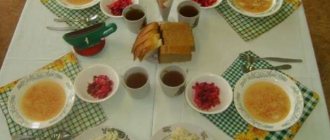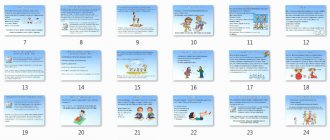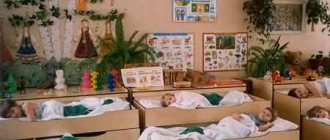Organization of walks in preschool educational institutions according to Federal State Educational Standards
Pedagogical consultation for teachers
Organization of a walk in kindergarten according to the Federal State Educational Standard for Preschool Education: basic requirements
A walk is a mandatory element of the daily routine in kindergarten. The objectives of the walk are to give each child the opportunity to unwind, relieve tension after statistical, focused activities and create a cheerful mood
Meaningful activities in the fresh air are a favorite pastime of preschoolers, so the methodology for conducting a walk in a preschool educational institution according to the Federal State Educational Standard is of paramount importance. The content of walking activities is determined according to the program for introducing children to the outside world as part of calendar planning, taking into account:
1. Weather conditions (in the cold season, it is advisable to start a walk with outdoor games or performing work assignments that help maintain optimal body temperature, on rainy days - with sedentary activities that allow you to stay under the roof (games, stories, observations), on hot days - experimenting with water).
2. Previous types of activities (if the walk was preceded by active intellectual work, it is advisable to provide preschoolers with the opportunity to satisfy the age-related need for movement and throw out emotions during outdoor games, but if before going outside the children were involved in physical or musical activity, you can immediately begin observations , completing projects, developing quiet games).
The key to a useful and exciting walk that meets the requirements of the Federal State Educational Standard for Education and allows you to implement current pedagogical tasks is the use and consistent change of the following structural components of the walk:
| Mandatory structural elements of a walk | Description and recommendations |
| Observation | Pre-planned practice of observing phenomena, objects, objects, which can be carried out with a group or separate groups of children, is an important element of walking activities. The active all-round development of preschoolers is facilitated by observation of: · objects of wildlife - plants and birds on the site, animals - during walks outside the OS; · natural phenomena - the movement of clouds at different times of the year, rain, snowfall and melting; · labor of adults - janitor, driver, builder, etc. In accordance with the recommended methodology for conducting a walk in a preschool educational institution according to the Federal State Educational Standard, observations are implemented according to the following algorithm: 1. Establishing a fact (clouds are moving across the sky). 2. Formation of connections between parts of the object. 3. The accumulation of impressions obtained during observations (clouds move one after another, large clouds move slower than small ones). 4. Carrying out comparisons (clouds move in the presence of wind). 5. Summing up (in the fall the clouds move quickly, and in the summer - slowly). In order to accumulate significant life experience in children and expand knowledge about the world around them, different types of observations are carried out during a walk: 1. Short-term, designed to form primary ideas about objects and objects (what a sparrow looks like, what sounds it makes). 2. Long-term, contributing to the expansion of existing knowledge (seasonal changes in deciduous trees, stages of flower growth, the process of snow changing during the winter months). When organizing observations, it is necessary to take into account the age factor. With younger preschoolers, who are characterized by significant absent-mindedness, observations are carried out for 7-10 minutes, with pupils of the senior and preparatory groups - 15-25. Contemplation of the surrounding nature is carried out daily, with a mandatory change of objects of observation and the duration of this type of activity to maintain the high interest of the kids. |
| Physical activity (sports and outdoor games) | In order to preserve and strengthen children's health, prevent intellectual stress and develop moral qualities, when organizing walks in kindergarten, according to the Federal State Educational Standard, a significant place is given to play activities, namely: · outdoor games associated with running, jumping, throwing objects, avoiding obstacles, maintaining balance; · folk games; · games with elements of sports activity (relay races, small towns, dribbling the ball according to the rules of basketball); · playing with water; · sedentary games with an intellectual component (guessing an object by description, searching for general characteristics). When organizing play activities during a walk, it is important for the teacher to take into account weather conditions, age factor and time spent in the fresh air. Duration of outdoor games: · on a morning walk it is 6-10 minutes for pupils of the junior group, 10-15 for the middle group and 20-25 for the senior and preparatory groups; · on an evening walk - 10-15 minutes for younger preschoolers, 12-15 minutes - for older children. To ensure maximum activity of pupils, the content of physical activity is selected taking into account age-related skills: · with children of the younger group, it is recommended to play games with text accompaniment, involving repetition of the same type of actions; · middle group - role-playing games with preliminary preparation; · senior and preparatory groups - sports competitions, relay races, story-based entertainment games. The physical activity cluster ends with a gradual decrease in the level of activity through sedentary activities. Current methodological recommendations provide for the need to learn 3-4 new games with students every month with their subsequent repetition. |
| Individual work in various areas of development | In order to provide optimal conditions for harmonious age-related development during the walk, the teacher conducts short individual classes of cognitive, speech therapy, physical, social and personal orientation. Individual work with students is reflected in an individual plan; it may include conversations, games with various objects, learning tongue twisters, and performing exercises to develop dexterity, attentiveness, and balance. The teacher prepares the materials and equipment necessary for conducting individual pedagogical work in advance. |
| Labor activity | Planning the work activities of preschoolers while spending time in the fresh air is an important component of the methodology for conducting walks in preschool educational institutions according to the Federal State Educational Standard. Provided that work assignments are feasible, exciting and varied, this type of activity helps to unite the children's team and develop significant skills - determination, readiness for mutual assistance, responsibility, initiative. Work activity during a walk can be organized through: · Carrying out individual work assignments - this form of work takes time, but is suitable for children of all age groups; · work in groups; · collective work. Taking into account age, labor activity in kindergarten groups is implemented as follows: 1. The teacher gives the pupils of the junior group simple instructions, including 1-2 actions (bring one flower and a leaf for the herbarium). Children work in close proximity, but there is no relationship of interdependence. Group activities are completely controlled by the teacher. 2. The teacher pre-divides the children of the middle group into subgroups, pronouncing the tasks and features of their implementation for each, after which he systematically controls the quality of the work of each “work group”. 3. Children of senior preschool age are given a task, after which the teacher initiates a collective discussion of the procedure, helps in the distribution of roles, while the children independently implement the assigned work task with little help from the teacher. |
| Independent activity | Independent walking activities of children are organized under the supervision of a teacher with full safety ensured. This element of the walk promotes the development of initiative, communication skills, and the use of various types of aids, taking into account their purpose. |
It should be noted that the procedure for implementing the structural elements of a walk, the duration of which (with the exception of independent activity of preschoolers) should not exceed 7-15 minutes, can be varied by the teacher, taking into account weather conditions, daily routine, well-being and mood of children and other factors. When conducting walking activities, it is important for a responsible teacher to pay special attention to children with little initiative, who have a reduced need for physical activity, and pupils with disabilities, in order to prevent prolonged stay in the fresh air without movement, which carries high health risks.
The need to rethink the established traditions of preschool education, dictated by changes of a social nature, determines the advisability of conducting various types of walks in kindergarten according to the Federal State Educational Standard of Preschool Education. In addition to walking activities organized using established structural components, the active comprehensive development of pupils is facilitated by:
1. Walk-event
2. Entertaining walk with a character
3. Sports walk
4. Walk - labor action
5. Walk - hike
Types of walks with children that teachers can take in the summer
| Peculiarities | Recommendations on how to organize |
| Entertaining walks with a character | |
| Goals of walks and entertainment Emotionally and psychologically relieve children, create a positive emotional background, satisfy the needs for physical activity. Content Such walks can be varied and variable, depend not only on the goals and objectives set, but also on the thematic focus and semantic richness. Result Walking with a character motivates children to a certain type of activity, help to interest all children in the group, involve them in joint play activities, observations, work | Plan a walk with your character in advance and think through its scenario in detail. Focus on the outdoor leisure scenario, since the scenario for this type of walk is similar to it. Play the game with the character several times, if the kids liked it. At the same time, some pupils can engage in independent play activities. In younger groups, use character toys: rubber, bibabo and others of your choice. Use toys that are new to children to spark their interest. In younger groups, play the role of the character yourself, speak for him in order to involve children in joint gaming activities. In a group of senior preschool age, it is better to give the role of the character to a teacher of another group, a parent or a senior preschooler from another group |
| Walking events | |
| Goals of the walk-event To promote the mental, moral, aesthetic education of preschool children, to develop their curiosity. Content The walk is dedicated to a specific topic that is associated with all types of children's activities. For example, Children's Day. You can dedicate this walk to an event in kindergarten. For example, they brought and installed a new playground and sports equipment, and updated the sand in the sandbox. Result A walk-event enriches the knowledge of pupils, expands their understanding of the world around them, satisfies their need for experiences and experiments, develops creativity, maintains interest in the walk as a routine moment and creates a desire to go for a walk. Helps the teacher emphasize the importance of the event, clarify the children’s knowledge, and find out the nature of perception of a certain topic | Carry out a walk-event with children of junior and senior preschool age. Announce the walk - hang an announcement or poster in the locker room for children about the upcoming event. Think about the conditions for the walk in advance. Use a variety of outdoor materials to keep children interested in the walk. Go through the children’s route yourself and determine where it will be convenient to stop for observation, where you can play an outdoor game with the students, etc. Include in the walk-event: an organizational moment - to unite the children's team, a conversation about the upcoming event; introduction to the topic of the walk - introduction to the event; outdoor and didactic games, children's experimentation, etc.; independent creative activity of children. Plan the number of such walks taking into account the characteristics of the children's group, social events and interesting dates, but not often |
| Sports walks | |
| Purpose of sports walks Strengthen the health of preschool children, help prevent fatigue, physical and mental development, and help optimize children's motor activity. Content Sports outings are not as strictly structured as sports events and entertainment. They provide students with freedom of choice and allow them to take into account their interests and desires. Sports walks include a variety of elements of children's sports-themed activities. The emphasis should be on developing physical qualities in children, nurturing an interest in sports and a healthy lifestyle. At the same time, a sports walk cannot be filled only with motor activities. It is also recommended to include cognitive and sports-oriented tasks. The scenario for the sports walk is drawn up by the physical education teacher together with the group teacher. Pupils play together during a sports walk with a teacher or physical education teacher. Depending on the weather conditions, children’s physical activity during a walk can be of varying intensity so that they do not become overcooled or overheated. The teacher determines this before going for a walk, taking into account weather conditions. Result When properly organized, sports walks have a hardening effect on the child’s body in natural conditions and increase the level of physical fitness of preschoolers | Take exercise walks at least once or twice a month. Plan your sports walk scenario in advance. Include in the walk script: an organizational moment or an introductory conversation; outdoor, sports games; sport exercises; independent activities of children; individual work in various areas of development of students; summing up the walk, creative task. Allow at least half of the entire walk for sports games. During your walk, alternate tasks with high physical activity and games of low mobility, team games and subgroup, individual exercises. During your walk, maintain a balance between motor activities and cognitive and sports-oriented tasks. For example, these could be didactic games, games for attention, imagination, literary tasks (riddles, counting rhymes, poems). Consider children’s experience of using objects: racket, ball, jump rope, etc. Introduce children to various sports and athletes during the walk. Organize a targeted walk with your children to a stadium (city, school, courtyard) to watch how athletes or schoolchildren are engaged (if there is no ban on leaving the territory of the kindergarten due to quarantine measures). Organize a variety of outdoor games of a plot nature, which include basic movements, with children of primary preschool age during a sports walk. Build simulated sports grounds where older students will play with younger ones, give them motor tasks, and teach them certain motor skills. Conduct conversations with older preschool children about the history of the development of sports, ancient and modern sports games, and the Olympics. Organize thematic role-playing games in which students can try on the roles of a commentator, judge, spectators, athletes, ticket sellers, etc. Gradually, starting with the older group, introduce into the walk scenario team sports games adapted for preschool age: pioneer ball, football, volleyball, tennis, etc. |
| Walks – labor actions | |
| Purposes of walks - labor actions The purpose and objectives of such walks are determined by the teacher in accordance with the acquired skills and work abilities of the pupils, as well as their physical capabilities. Content Walks - labor actions - are specially organized subject-based practical labor activities of children limited in place and time. The peculiarity of such walks is the predominance of work assignments and different organized forms of work on the street in accordance with weather conditions, without reducing the overall motor activity of children. Several types of work assignments that replace each other sequentially during the walk and at the same time logically connected with each other, avoiding tiredness of children. Result Preschoolers are introduced to different forms of work in accordance with the season and weather conditions. Children start understand that working in nature is not a game or entertainment, but a serious activity. The teacher instills in them a desire to participate in caring for plants, feeding birds, cleaning the area (cleaning the veranda of sand, leaves, etc.). Children learn to work collectively | Carry out walks and labor events regularly, but not more than two or three times a month. A significant amount of time must be devoted to work activities. Organize such walks on the territory of the kindergarten, taking into account the season. Include in your walk observations, for example, of seasonal changes in nature, the growth and development of plants, the arrival and migration of birds, human labor in nature, and joint work with children. Be sure to evaluate the work done at the end of the walk. Plan work assignments for each child, taking into account his capabilities and individual characteristics during the walk. The load should be feasible. Alternate several types of work assignments, change them consistently during the walk, maintaining a logical connection between them. Include surprise moments in your walk: an unexpected task for children, a meeting with a fairy tale character or your favorite hero, watching a janitor at work. Involve younger preschoolers on walks to carry out simple tasks: sowing large flower seeds, planting onions, watering plants in the beds, picking vegetables. Give students in the middle group independent assignments. For example, they can loosen the soil, care for plants, grow vegetables and flowers on the plot together with you: clear the soil of stones and sticks, water beds, flower beds, and collect vegetables. Instruct older preschoolers to loosen the soil, water, weed, thin out and tie up plants, and harvest. Teach preschoolers how to properly use a shovel, scoop, rake, and watering can. Make sure that the maximum time allotted for labor activities for older preschoolers does not exceed 30–40 minutes. Organize children’s work activities during a walk in the morning or evening, and not during the hottest hours of the day. Make sure that materials and tools for child labor during walks comply with hygienic requirements and rules for protecting the life and health of children. Do not give children anything to work with that could create a traumatic situation or adversely affect their health and physical development |
| Walking tours | |
| Goals of the walk A hike is one of the types of walks, during which teachers solve health problems, improve motor skills and physical qualities of children. Content This is a special type of walk that differs from the traditional one in form, content and unusual organization. Teachers organize walks with children in the forest, park, square, as well as in the green area on the territory of the kindergarten. Walking trips require serious preparation of the teacher and the children. Result During the hike, children satisfy their cognitive needs, learn to love nature and see its beauty. Such walks add variety to the usual life of preschoolers | Take walks and hikes with older preschool-age children. At this age, children are quite independent, and friendly relationships develop between them. Prepare your children in advance for the hike. Plan no more than two or three such walks during the school year. First, organize a walk-hike on the territory of the kindergarten. Take a walk outside the kindergarten territory when the children are ready for it and there are no restrictions. Organize preliminary work with your children before the hike. Include a conversation, relay games, reading fiction and watching tourism videos. Introduce the pupils to the attributes necessary for a hike: tent, backpack, bowler hat, sleeping bag, etc. Start the walk-hike with an organizational moment: gather all the children, conduct a roll call and briefing, even if the walk is planned on the territory of the kindergarten. Organize short stops for rest and observation of interesting objects while the group is moving to a halt. Include a surprise moment in your hike: an unexpected meeting or an interesting task for preschoolers. Choose a convenient place for the final destination of the hike - a rest stop, where you can put up a tent, make a fire, and organize games. Play games during breaks and rest that will stimulate cognitive and intellectual activity of children, outdoor and sports games. Provide students with the opportunity to show independence and experience for themselves all the difficulties in organizing everyday life during a hike, for example, ask them to help set up a tent. Involve children in cleaning up the area at the end of the break. Organize short stops for rest and observation on the way back |
Next, practical work is carried out with teachers to develop mini-notes of the following types of walks: Walk-event; An entertaining walk with a character; Sports walk; A walk is a labor action; Walk - hike. Practical work is carried out using the “World Cafe” technology.
Given the importance of maintaining high cognitive interest among a generation of children growing up in a rapidly changing world, the teacher has the right to actively experiment with forms of walking activities, maintaining the mandatory structural components of a walk - the organized activity of preschoolers under the guidance of a teacher, the interaction of children without the intervention (but under the control) of an adult , child self-employment. An equally important point is to maintain an optimal balance between play and other types of activities, due to the fact that the first, as the main way for children to get to know the world, should remain a priority.
How children's playgrounds should be equipped from the point of view of SanPiN
Space.
It is not said what size the playground should be in kindergarten. But, firstly, it is clear that it should be enough for all groups. Secondly, areas of different groups must be separated from each other. Thirdly, a shady canopy should be placed on the site, which is often equipped as a veranda, sandboxes, and a place for games and sports activities. Fourthly, you can focus on the old Sanitary Regulations and Regulations, according to which there should have been at least 9 sq.m. per child. playground.
The coating must be soft, natural or polymer, without defects. If defects appear, the coating must be changed. Of course, this is not hard asphalt.
Equipment.
The site should have a canopy, sandboxes, and equipment for children's games. There are no exact requirements for equipment in the documents - preschool organizations themselves decide which one is best for them. But all equipment must comply with GOST and SNiP (building codes and regulations). For example, any equipment should have rounded corners, and slides should have railings on the stairs and ramp.
In sandboxes, it is necessary to change the sand once a year - new sand must be tested in a laboratory for the absence of parasites.





